The Carnivore Diet is a very strict eating plan. You only eat foods that come from animals. You do not eat any plant foods at all. This makes the diet very limited. Many people call it a “zero carb” diet. This is because you take out almost all carbohydrates. You may wonder what this diet is and why people try it. Most people start the Carnivore Diet to lose weight. Some want to get healthier or make meals easier. In a recent survey, 93% of people said they wanted to lose weight. Up to 95% said their health got better.
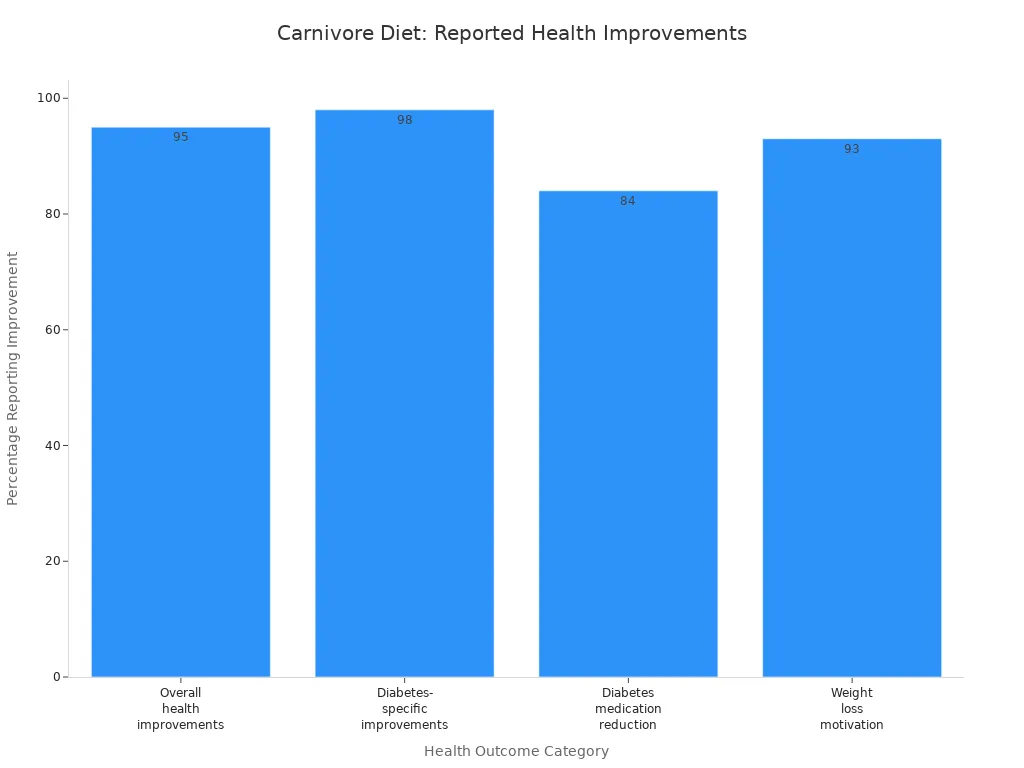
Carnivore Diet Overview
Core Principles
On the Carnivore Diet, you follow strict rules. You only eat animal-based foods like meat, fish, eggs, and sometimes dairy. You do not eat any plant foods. This means no fruits, vegetables, grains, nuts, seeds, or legumes. Most spices and processed foods are not allowed. Some people pick even stricter plans, like the Lion Diet. That version lets you eat only red meat, water, and salt. The main goal is to get all your calories from animal foods. This way, you almost never eat carbohydrates.
Tip: To keep things easy, choose fresh meats, fish, eggs, and a little cheese or butter.
Comparison to Other Diets
You might wonder how the Carnivore Diet is different from other diets. The biggest difference is how strict it is. The Carnivore Diet does not let you eat any plant foods or carbs. Other animal-based diets are less strict. For example, ketogenic and Atkins diets limit carbs but do not cut them out. Paleo diets let you eat fruits, vegetables, nuts, and seeds. These diets are not as strict as the Carnivore Diet.
Here is a table that shows the differences:
| Aspect | Carnivore Diet | Other Animal-Based Diets / Related Diets |
|---|---|---|
| Allowed Foods | Only animal products: meat, fish, eggs, some dairy | Animal products plus some plant foods or fruits |
| Excluded Foods | All carbs, fruits, vegetables, grains, legumes, nuts, seeds, processed foods | May include some plant foods and spices |
| Carbohydrate Intake | Essentially zero | Limited but not zero (e.g., keto, Atkins) |
| Variations | ‘Lion Diet’ restricts to red meat, water, salt | May include fruits, dairy, and some plant foods |
| Focus | Strictly fat and protein from animal sources | More flexible; majority animal foods but not exclusive |
| Nutritional Concerns | Risk of deficiencies due to lack of plant foods | Fewer deficiencies if some plant foods included |
The Carnivore Diet is known for cutting out all foods that are not from animals.
Why People Try It
Many people try the Carnivore Diet for health reasons. Losing weight is a big reason. Some want to help their metabolism or manage diabetes. Studies show most people who follow this diet feel happy with it. They often see lower body weight and better blood sugar. Some need less diabetes medicine. People also say their skin looks better and their digestion improves. Some notice less swelling and a better mood. The diet is simple and easy to follow. You do not have to count calories or track what you eat. Many people try it after other diets did not work for them.
How It Works
Science and Mechanisms
Ketosis
When you eat only animal foods, your body goes into ketosis. In ketosis, your body uses fat for energy instead of carbs. You eat almost no carbs, so your liver makes ketones from fat. These ketones give your body energy. This helps your body burn fat that is stored. Burning stored fat can help you lose weight.
Carb Elimination
Taking out carbs changes how your body works. With no carbs, your insulin levels go down. Insulin is a hormone that helps use sugar from food. When insulin is lower, your body burns more fat for energy. You might feel less hungry because protein makes you feel full.
Note: High-protein diets can help you eat fewer calories by making you less hungry.
Here is a table that shows the main ways the diet works:
| Mechanism | Explanation | Metabolic Effect |
|---|---|---|
| High protein-induced satiety | High-protein diets make you feel full and less hungry, so you eat fewer calories. | Helps with weight loss by lowering cravings and calorie intake. |
| Carbohydrate elimination | Eating almost no carbs puts you in ketosis, so your body uses fat for energy. | Helps burn fat and lose body fat. |
| Reduced insulin levels | No carbs means your body makes less insulin, so you do not get insulin spikes. | Makes it easier to burn fat and helps your body use insulin better. |
| Increased fat oxidation | Low-carb diets help your body burn more fat for energy, with help from special enzymes. | Makes fat burning work better and helps with weight loss. |
If you eat this way for a long time, your metabolism changes. Your liver makes sugar from protein, which is called gluconeogenesis. This keeps your blood sugar steady, even without carbs. Your body also gets better at using fat for energy.
Body Response
Metabolism
Your metabolism changes when you eat only animal foods. Eating lots of protein turns on special genes in your liver and kidneys. These genes help your body use more protein and fat. They also help your body get rid of extra nitrogen from protein. This helps you burn fat and keep your blood sugar steady. Over time, your body gets better at using fat for energy.
Blood Sugar
When you stop eating carbs, your blood sugar stays steady. You do not get big jumps after eating. Your liver makes sugar from protein and fat for your body. Some people see better blood sugar and A1C levels on the Carnivore Diet. But eating a lot of saturated fat can make your cells less sensitive to insulin. This means your body may not use sugar as well, which can cause health problems later. Experts say that even if your blood sugar looks better, eating too much saturated fat can hurt your heart and insulin sensitivity.
Tip: If you have diabetes or other health problems, talk to your doctor before starting a zero-carb diet.
Carnivore Diet Food List
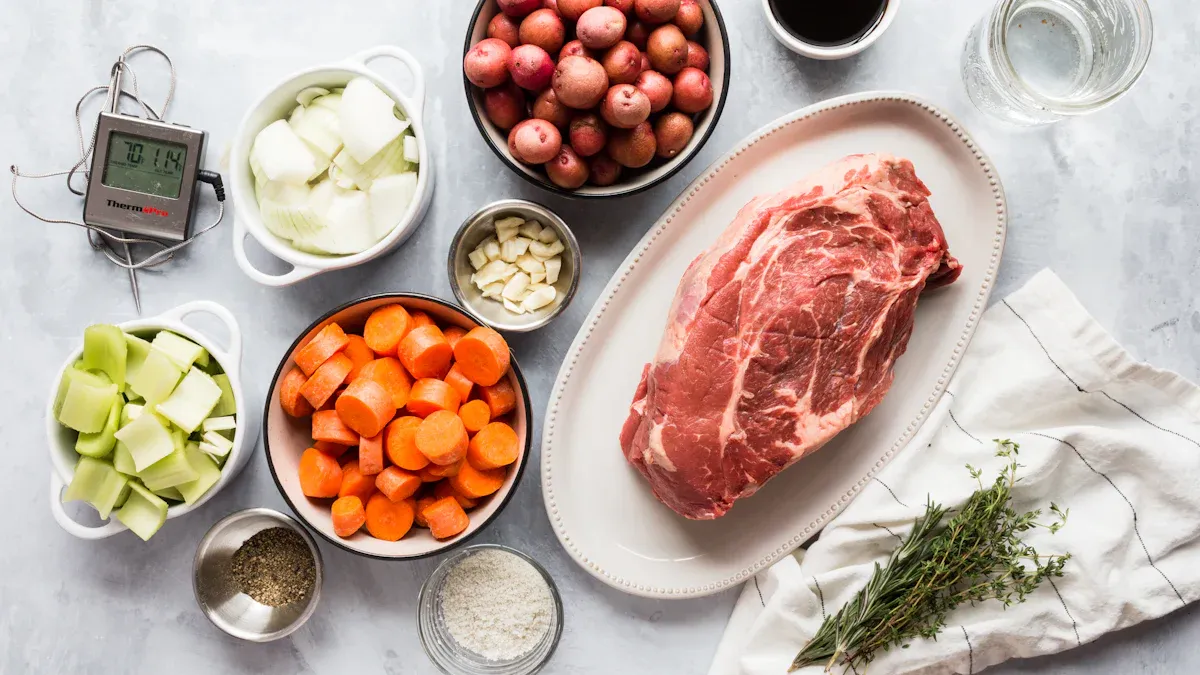
Picking the right foods is very important on the Carnivore Diet. You eat only animal foods and skip all plant foods. This part explains what you can eat, what to avoid, and how to shop.
Allowed Foods
Meats
You can eat many kinds of meat. These are:
- Beef (ribeye, ground beef, steak, brisket)
- Lamb (chops, leg, ground lamb)
- Poultry (chicken thighs, drumsticks, turkey)
- Game meats (venison, bison, elk)
Meats give you protein, iron, zinc, and B vitamins. Many people pick fatty meats for more calories and to help with ketosis.
Fish & Seafood
Fish and seafood are great for protein and healthy fats. You can have:
- Fatty fish (salmon, sardines, mackerel)
- White fish (cod, haddock, tilapia)
- Shellfish (shrimp, crab, lobster, oysters, mussels)
- Canned fish with bones (sardines, salmon)
These foods have omega-3s, calcium, and magnesium. Smoked or pickled shellfish, like oysters and mussels, give you iron and other minerals.
Eggs & Dairy
Eggs are a main food for many people on this diet. You can eat:
- Chicken eggs (boiled, scrambled, fried)
- Duck eggs
Eggs have protein, folate, and iron. Some people eat dairy, but not everyone does. If you can eat dairy, you might have:
- Butter
- Heavy cream
- Hard cheeses (cheddar, parmesan)
- Cultured dairy (yogurt, kefir)
Pick low-lactose dairy to keep carbs low. Some people skip dairy to avoid stomach problems or swelling.
Animal Fats & Organs
Animal fats and organ meats are full of nutrients. You can use:
- Tallow (beef fat)
- Bone marrow
- Bone broth
- Liver (beef, chicken)
- Heart, kidney, tongue
Organs like liver and heart have vitamins A, C, folate, and iron. Bone broth and marrow give you collagen, calcium, and magnesium.
Tip: Eating different meats and organs helps you get more nutrients.
Here is a table with common foods and their main nutrients:
| Food Category | Examples | Key Nutrients Provided |
|---|---|---|
| Tinned fish with bones | Sardines, salmon, mackerel | Calcium, magnesium, omega-3s |
| Smoked/pickled shellfish | Oysters, mussels | Iron |
| Eggs | Boiled eggs | Folate, iron |
| Dried/smoked fish | Various dried fish | Omega-3 fatty acids |
| Liver products | Liver pate | Iron, folate, vitamin C |
| Broths | Bone broth, eggshell broth | Calcium, magnesium |
| Dairy products | Yogurt, kefir, cheese | Calcium |
| Bone marrow | Bone marrow | Vitamin A |
Foods to Avoid
Plant Foods
You must not eat any plant foods. This means:
- Vegetables (broccoli, potatoes, spinach, peppers)
- Fruits (apples, bananas, berries, oranges)
- Grains (rice, wheat, bread, pasta)
- Legumes (beans, lentils, peanuts, soybeans)
- Nuts and seeds (almonds, walnuts, pumpkin seeds, sunflower seeds)
- Plant-based oils (olive oil, canola oil, coconut oil)
These foods have carbs and plant parts that the Carnivore Diet does not allow.
Processed Foods
Processed foods are not okay. You should skip:
- Sugars (table sugar, maple syrup, honey)
- Alcohol (beer, wine, liquor)
- High-lactose dairy (milk, soft cheese, yogurt)
- Packaged snacks (chips, crackers, cookies)
- Drinks besides water (soda, juice, coffee, tea)
The diet tries to cut out all carbs and extra stuff.
Here is a table that shows foods to avoid and why:
| Food Category | Examples Included | Rationale for Exclusion |
|---|---|---|
| Vegetables | Broccoli, potatoes, peppers | Plant-based, contain carbs |
| Fruits | Apples, bananas, berries | Plant-based, high in carbs |
| Grains | Rice, bread, pasta | Plant-based, high in carbs |
| Legumes | Beans, lentils, peanuts | Plant-based, high in carbs and fiber |
| Nuts and Seeds | Almonds, walnuts, pumpkin seeds | Plant-based, contain fats and carbs |
| High-lactose Dairy | Milk, soft cheese, yogurt | Contains lactose (sugar) |
| Alcohol | Beer, wine, liquor | Contains sugars and carbs |
| Sugars | Table sugar, maple syrup, honey | Plant-derived carbs |
| Plant-based Oils | Olive oil, canola oil, coconut oil | Non-animal origin |
| Beverages other than water | Soda, coffee, tea, juice | Non-animal origin, often contains carbs or additives |
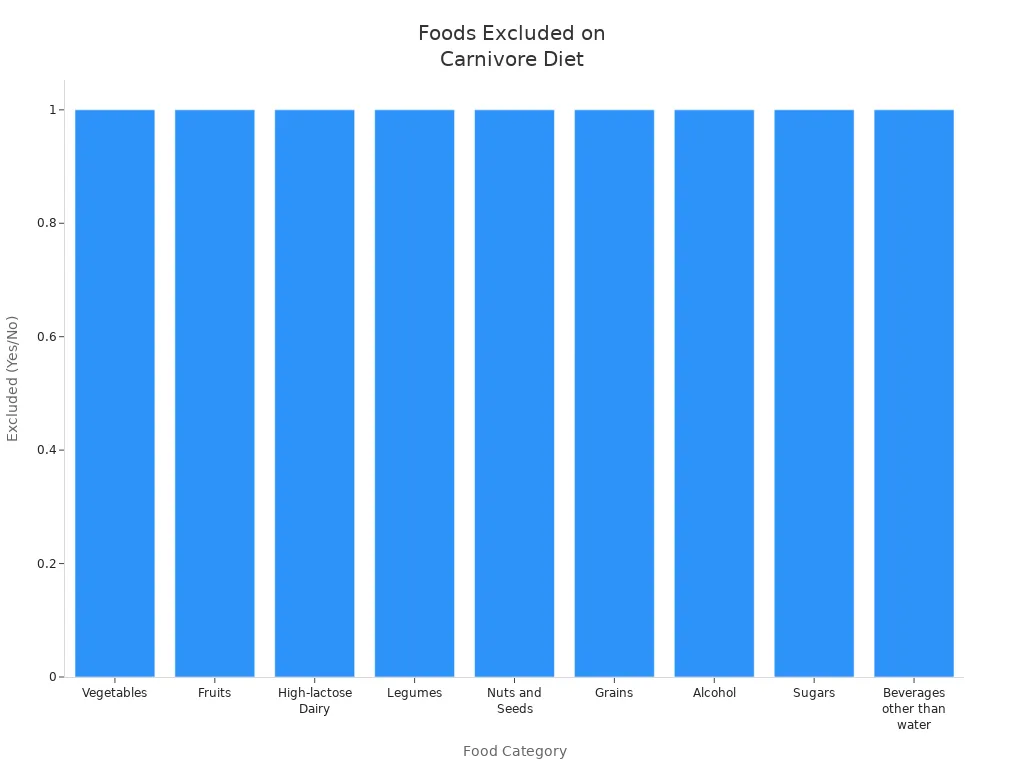
Note: Not eating plant foods and processed foods helps you keep carbs at zero.
Sample Shopping List
A good shopping list helps you stick to the diet. Here is an example of what you might buy each week:
| Item | Typical Quantity | Approximate Cost | Meals Yielded |
|---|---|---|---|
| Ribeye | Around 2 kg | About $50 | About 6 meals |
| Ground Beef (80/20) | Around 2 kg | About $25 | 6–8 meals |
| Chicken Thighs (skin-on) | Around 1.5 kg | About $12 | 4–5 meals |
| Eggs | 1 dozen | About $4 | 4–5 meals |
| Sardines (canned) | 7 cans | About $10 | 7 meals |
| Beef Liver | 500 g | About $3 | 2–3 meals |
| Tallow or Butter | 500 g | About $6 | Used for cooking |
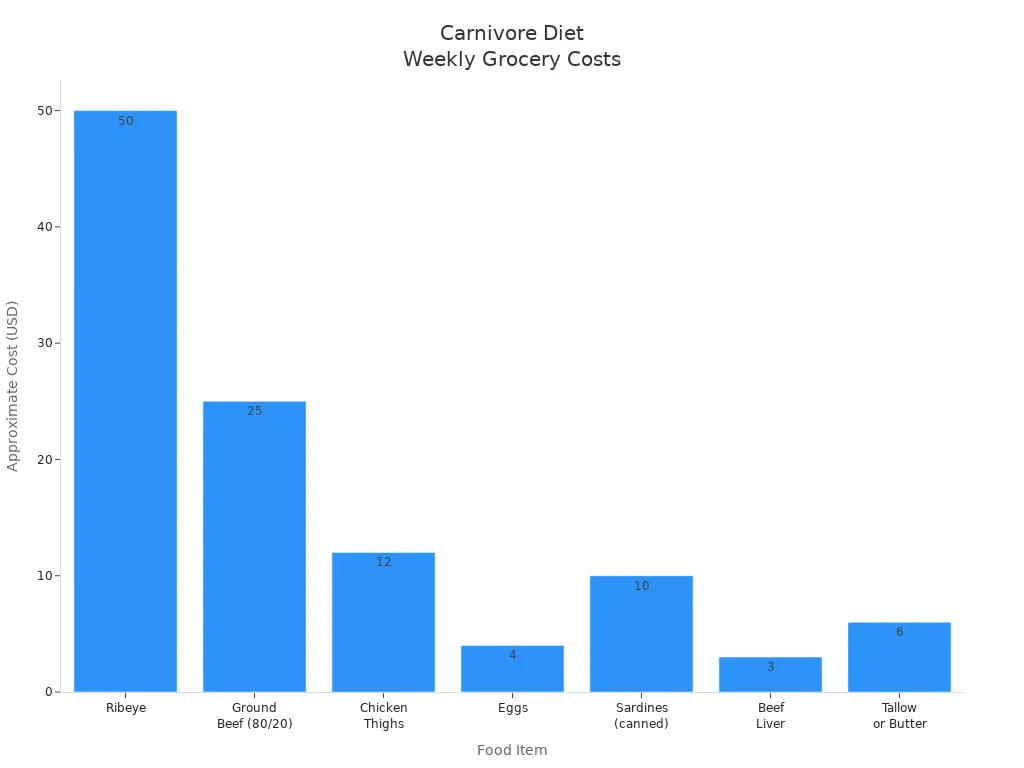
You can mix these foods in different ways each week. For example:
- Day 1-2: Ground beef patties and eggs
- Day 3-4: Chicken thighs and bone broth
- Day 5: Ribeye steak
- Day 6-7: Sardines, liver, and eggs
Tip: Buy bigger amounts to save money and always have animal foods ready.
The 80/20 Rule and Meal Plan Variations
Some people use the “80/20 rule” to make things easier. This means you eat 80% animal foods and up to 20% other things, like coffee or spices. But many people want to eat only animal foods for the best results.
You can change your meal plan to fit what you like. Some people eat just beef and salt. Others eat many kinds of meat, fish, eggs, and dairy. The most important thing is to find what works for your health and body.
Benefits
Weight Loss
A lot of people pick the Carnivore Diet to lose weight. You stop eating all carbs, so your body uses fat for energy. Eating lots of protein helps you feel full. This means you might eat less food. You can reach your calorie goals more easily.
Here is a table that shows what studies say about losing weight on low-carb, high-protein diets:
| Evidence Aspect | Description |
|---|---|
| Meta-analysis (2013) | Low-carb diets helped people lose more weight and fat than low-fat diets. This supports cutting carbs for weight loss. |
| High-protein diets (Flood-Obbagy et al., 2006) | Eating more protein made people feel full and less hungry. This helps you eat fewer calories. |
| Low-carb, high-protein diet (Volek et al., 2004) | People lost more fat and had better health numbers than those eating lots of carbs. |
| Insulin reduction (Ludwig DS, 2002) | Eating no carbs lowers insulin, which helps burn fat and lose weight. |
| Increased fat oxidation (Gannon et al., 2004) | Low-carb diets help your body break down and use fat for energy. This helps you lose fat. |
| Health markers (2012 study) | High-protein, low-carb diets lower cholesterol and triglycerides. This makes your health better. |
You might see stories online about people losing weight fast on this diet. Some surveys say people on the Carnivore Diet go from overweight to normal BMI. But these stories are from people who really stick to the diet. The results may not be true for everyone. Some experts think weight loss happens because you stop eating junk food, not just because you eat animal foods. Studies do not prove this diet always works or is easy. The Carnivore Diet can be hard to follow and may not work for all people.
Mental Clarity
Many people say they can think better on the Carnivore Diet. In one small study, people with gut problems said they felt more focused. One person said their mind felt “freakin’ awesome.” Another report told about someone with schizophrenia who felt happier and could think more clearly after starting a carnivore ketogenic diet.
A survey of over 2,000 strict followers found that 95% felt their mind was clearer, their mood was better, and they had less anxiety. Some people even stopped needing medicine for their mental health. Most of these stories are personal, but they show you might notice changes in how you feel and think.
Many people say their mind feels sharper and their mood gets better when they eat only animal foods.
Inflammation
Some people try the Carnivore Diet to help with pain and swelling. The idea is that taking out plant foods might lower inflammation by removing plant toxins. Research on red meat and inflammation does not always agree. Most studies show that eating lean red meat does not raise inflammation markers like CRP or TNF-α.
| Study Type/Design | Diet/Intervention | Inflammatory Markers Assessed | Key Findings |
|---|---|---|---|
| Controlled 4-week diet trial (n=47) | High red meat, high dairy, control diets | CRP, TNF-α, TNF-α/sTNF-RII | No big differences in inflammation between diets |
| 8-week parallel study | Lean red meat replacing carbohydrates | Inflammation and oxidative stress markers | No rise in inflammation or stress markers |
| Rotterdam sub-cohort | Processed meat vs lean red meat and chicken | CRP | Processed meat was linked to higher CRP. Lean red meat and chicken were not linked. |
Some experts think eating only animal foods might help your gut and lower swelling, especially for people with gut issues. But most proof comes from stories or small studies. We need more research to know if this diet really helps with inflammation.
Simplicity
Meal planning gets much easier with this diet. You do not have to count calories or weigh your food. You just eat animal foods until you are full. Many people say, “Eat a steak when you are hungry.” This way, you do not need to worry about recipes or long shopping lists.
You can try different meats and animal foods for variety. There is no need to think about meal times or how much to eat. You only eat enough to feel full. This simple way helps you stick to the diet and makes choices easier.
- Planning meals is easy and feels good.
- Cooking many steaks at once saves time.
- A slow cooker makes meat soft with little work.
- Making single servings lets you reheat food quickly.
- Slowly eating more animal foods can help you adjust.
- At restaurants, pick meat dishes and ask for simple changes.
Shopping for food takes less time. You only go to the meat and dairy aisles. You do not need to buy lots of foods or check for hidden ingredients. This makes the diet easy to keep up, even if you are busy.
Many people say eating this way is so simple that it helps them keep going for a long time.
Anecdotal Health Effects
Many people share stories about feeling better on this diet. Some say they have more energy and feel happier. Others say they lose weight more easily. Some people feel less worried or sad. Others say they can think more clearly.
- People often say their health and mood get better.
- Some lose weight, but not everyone does or keeps it off.
- You might hear about better moods and steady energy.
- Some people get side effects like stomach problems, cramps, hair loss, trouble sleeping, dry skin, or changes in periods.
- Some studies say eating more meat may lower sadness and worry, but most proof is from stories.
- Low-carb diets might help mood by lowering swelling, but strong proof is missing.
Remember, these stories are from people’s own lives. They do not replace advice from doctors or real studies. Some health problems do not show signs, so watch your health and talk to a doctor if you are worried.
Note: This diet is very strict and can be hard to follow for a long time. Always pay attention to your body and get help if you notice problems.
Risks

Nutrient Deficiencies
Eating only animal foods can make it hard to get all nutrients. Many vitamins and minerals mostly come from plants. If you do not eat many kinds of animal foods, you might miss important nutrients. Some nutrients are almost impossible to get from just meat, even if you eat organ meats.
Vitamins & Minerals
You might not get enough vitamins and minerals. The table below shows which ones are most likely to be low and why:
| Nutrient | Deficiency Reason | Health Impact / Notes | Sources / Evidence Highlights |
|---|---|---|---|
| Vitamin C | Very difficult to obtain from meat alone, even with organ meats; requires raw or lightly cooked organs | Deficiency leads to scurvy symptoms (irritability, tooth loss, poor wound healing, brittle bones) | Multiple cases of scurvy reported in strict carnivore dieters; recommended intake 75-90 mg/day; organ meats contain some vitamin C but risk of toxicity with excess vitamin A from liver |
| Vitamin E | Hard to source adequately from meat; best sources include fish eggs (roe), salmon, grass-fed beef | Low intake linked to oxidative stress and tissue damage; antioxidant role | Recommended intake 15 mg/day; typical meats low in vitamin E; grass-fed beef better but often insufficient alone |
| Manganese | Mostly found in plant sources; rare in meats except shellfish and beef tripe | Deficiency likely without supplementation; important trace mineral | Supplementation recommended; grass-fed bison and shellfish are rare carnivore sources |
| Lithium | Primarily from grains and vegetables, absent in meat-only diets | Not essential but beneficial trace mineral; likely deficient in carnivore diet | Plant-based sources are primary; carnivore diet lacks these |
| Plant Polyphenols | Absent in meat; important antioxidants found in plants | Protect against cancer, heart disease, nerve damage; support gut microbiota | Carnivore diet excludes these; supplementation suggested for antioxidant benefits |
| Fiber | Completely absent in meat; essential for gut microbiota health | Lack of fiber harms gut flora, may increase disease risk | Meat contains no fiber; fiber essential for gut health |
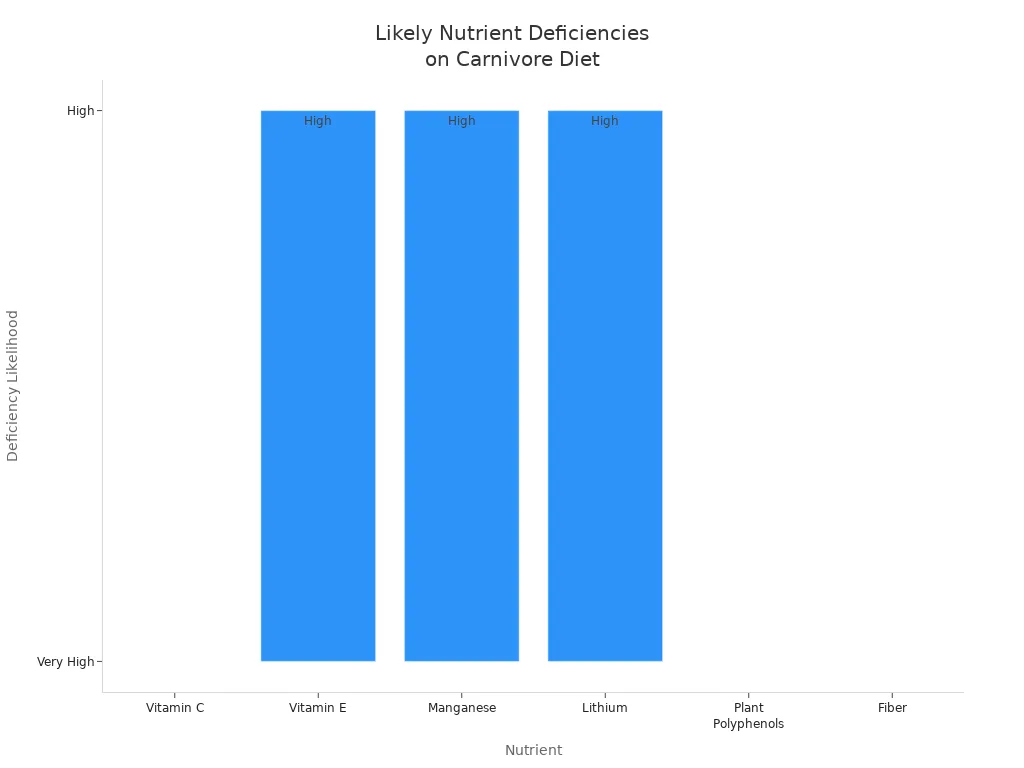
You might also not get enough magnesium, folate, or potassium. Magnesium is in eggs, fish, seafood, and cheese, but you need to eat enough of these. Folate is low in muscle meat but high in organ meats like beef liver. Potassium is in liver and oily fish, but you may still need supplements.
- Animal foods do not have fiber. Your gut bacteria need fiber to stay healthy. Without fiber, you might have gut problems or get sick more easily.
- Most meats have very little vitamin C. Organ meats like kidney have some, but not enough for most people.
- Manganese and lithium are almost missing from animal foods. These minerals help your body work well.
- Plant polyphenols, which protect your heart and brain, are not in animal foods.
Regular blood tests can help you check your vitamin and mineral levels. Eating many types of animal foods, especially organ meats, can lower your risk of missing nutrients. Still, you might need supplements for some things.
Some vitamins, like vitamin A and B vitamins, are easier for your body to use from animal foods. You can absorb these better than from plants. But you still need to eat many kinds of animal foods to get enough.
- Most people on this diet risk low vitamin C, fiber, magnesium, folate, and potassium.
- Organ meats help, but not everyone likes or eats them.
- You might not notice a problem right away, but issues can build up over time.
Heart Health
Eating only animal foods can affect your heart and blood vessels. Most animal foods have a lot of saturated fat and cholesterol. Eating too much can raise your risk for heart disease.
Saturated Fat
Animal foods like red meat, butter, and cheese have lots of saturated fat. Eating a lot of saturated fat can raise your LDL cholesterol, which is called “bad” cholesterol. High LDL makes your blood vessels narrow and stiff. This raises your risk for heart attacks and strokes.
| Evidence Type | Details |
|---|---|
| Observational Study (2021) | Survey of 2,029 carnivore diet followers showed elevated LDL cholesterol but optimal HDL and reported health improvements. |
| Expert Opinion (ACC) | Large-scale reviews link red meat (high in saturated fat) to increased cardiovascular disease risk and mortality. |
| Nutritional Facts | Animal-based foods like red meat, butter, and cheese are high in saturated fats, which raise LDL cholesterol. |
| Health Risks | Elevated LDL cholesterol narrows blood vessels, increasing heart attack and stroke risk. |
| Dietary Recommendations | CDC and experts advise limiting saturated fat intake and favoring balanced diets with fruits, vegetables, and whole grains. |
Doctors and heart experts warn that eating too much saturated fat can hurt your heart. The American College of Cardiology and the CDC both say to limit saturated fat. They recommend eating more fruits, vegetables, and whole grains for a healthy heart.
A case report told about a man who ate a lot of cheese and butter every day. His cholesterol went up to over 1,000 mg/dL, which is five times higher than normal. He got yellow bumps on his hands, a sign of very high cholesterol. His doctor told him to stop the diet and take medicine to lower his cholesterol.
Cholesterol
Eating only animal foods can make your cholesterol go up. This includes both LDL (“bad”) and HDL (“good”) cholesterol. High LDL is a strong risk factor for heart disease. Animal foods can also increase inflammation and stress in your body. These changes can damage your blood vessels and heart.
| Aspect | Evidence Supporting Negative Impact of Animal-Based Diets on Cardiovascular Health |
|---|---|
| LDL Cholesterol | Increased serum LDL cholesterol is a well-established risk factor for cardiovascular disease (CVD), and animal food consumption raises LDL levels. |
| Inflammatory Pathways | Animal-based diets increase toll-like receptor 4 (TLR4) signaling due to elevated serum endotoxins and oxidized LDL, promoting inflammation. |
| Oxidative Stress | Increased oxidative stress arises from enhanced NOX- and mitochondrial-derived reactive oxygen species (ROS) linked to animal food intake. |
| Lipotoxicity | Elevated free fatty acids and intracellular ceramides from animal foods contribute to cardiovascular lipotoxicity. |
| Renin-Angiotensin System | Upregulation of renin-angiotensin system components and angiotensin II type-1 receptor (AT1R) signaling is observed with animal-based diets, promoting CVD. |
| Trimethylamine-N-oxide (TMAO) | Microbial metabolism of choline and carnitine from animal foods increases TMAO levels, a molecule associated with CVD risk. |
| Clinical Observations | Early atherosclerotic changes correlate with cholesterol and inflammatory biomarkers in youth; plant-based diets can reverse such changes, unlike animal-based diets. |
| Public Health Recommendations | Evidence supports minimizing animal-based foods and promoting plant-based diets to reduce CVD risk; caution is advised with carnivore, ketogenic, and Atkins diets. |
Many heart doctors say you should get your cholesterol checked if you eat mostly animal foods. You should talk to your doctor about your heart risk before starting this diet.
Digestive Issues
Switching to only animal foods can upset your stomach and gut. Many people notice changes in their digestion, especially in the first few weeks.
- Diarrhea is common when you start. Your gut bacteria change because you stop eating carbs and fiber. The bacteria that eat carbs die off, which can cause loose stools.
- Your body needs time to make more bile and enzymes to handle the extra fat. This can take one to four weeks.
- Some people get constipation because they do not eat fiber. Less frequent bowel movements are normal, but hard stools or pain can be a problem.
- Nausea can happen as your gut and liver adjust to the new foods and higher fat.
Other causes of digestive problems include bile acid malabsorption, eating too much protein, or having trouble with dairy. You may also feel bloated or have cramps.
You can help your gut by drinking more water, eating enough salt, and changing your fat and protein balance. Some people use supplements like magnesium citrate or ox bile. Bone broth and gentle exercise can also help.
Most digestive issues get better after a few weeks. If you keep having problems, you should talk to a doctor or dietitian.
Who Should Avoid
This diet is not safe for everyone. Some people have more health risks with this strict plan. Doctors warn that some groups should not try this diet. There is not enough research to know if it is safe for everyone.
Groups who should avoid this diet include:
- People with kidney problems or kidney disease
Eating lots of protein can be hard on your kidneys. If you have kidney trouble, this diet could make it worse. - Individuals with heart disease or high cholesterol
Eating too much saturated fat and cholesterol can hurt your heart. If you have heart problems, do not try this diet without a doctor’s help. - Pregnant or breastfeeding women
Your body needs many nutrients when you are pregnant or breastfeeding. This diet does not give enough vitamins, minerals, or fiber for you or your baby. - Children and teenagers
Kids and teens need many foods to grow and stay healthy. A strict diet can cause them to miss important nutrients and harm their health. - People with a history of eating disorders
Strict food rules can bring back unhealthy eating habits. If you have had eating problems before, you should not follow a very strict diet. - Those with nutrient deficiencies or weak immune systems
If you already do not get enough vitamins or minerals, this diet can make it worse. People with weak immune systems need many kinds of foods to stay healthy. - Endurance athletes
Your body needs carbs for long workouts. This diet does not give enough energy for sports that last a long time. - Individuals on special diets for health reasons
If your doctor gave you a special diet, do not change it without asking them first.
Note: Experts say this diet does not have enough nutrition and could have unknown risks. Always talk to your doctor before starting a strict diet, especially if you are in one of these groups.
Pay attention to how you feel and talk to a doctor if you notice problems. A healthcare professional can help you know if this diet is safe for you.
Getting Started
Transition Tips
Starting an all-animal food plan can seem hard at first. You can make it easier by following these steps:
- Reduce carbs slowly. First, eat less bread, pasta, and sweet foods. Add more animal protein and fat to your meals. This helps your body get used to the change. It also lowers the chance of feeling sick.
- Support your digestion. If your stomach feels upset, try digestive enzymes or supplements like betaine and ox bile. These help your body break down fats and proteins.
- Stay hydrated and balance electrolytes. Drink lots of water every day. Add minerals like sodium, potassium, and magnesium. Bone broth and sole water are good for natural electrolytes.
- Watch for symptoms. You might feel tired, get headaches, or have muscle cramps. Go slow and use supplements for a short time if you need them.
- Prevent oxalate dumping. If you ate many plant foods before, switch slowly. Drink enough water and make sure you get enough calcium and magnesium.
- Adjust for your starting diet. If you ate lots of carbs or low-fat foods before, start with lean meats or easy-to-digest animal foods. Slowly add more fat and protein.
- Consider gut support. Some people use gut healing kits or special supplements to help during the first weeks.
Tip: Pay attention to how you feel. If you feel sick, slow down and ask a healthcare professional for help.
Sample Meal Plan
A normal week on this diet has many animal foods. Here is a sample plan:
| Day | Breakfast | Lunch | Snack | Dinner |
|---|---|---|---|---|
| 1 | Steak and eggs | Salmon | Cottage cheese | Ground beef patties |
| 2 | Feta cheese omelette | Chicken thighs with cheddar cheese | Chomps meat sticks | Ribeye steak |
| 3 | Poached eggs with bacon | Tuna and hard boiled eggs | Sardines | Bone broth and roasted chicken |
| 4 | Kefir and two eggs over medium | Shredded chicken with bacon | Tuna | Bison burgers |
| 5 | Chicken livers and scrambled eggs | Turkey burgers | Hard boiled eggs | Slow roasted salmon |
| 6 | Chicken and feta omelette | Beef liver | Sardines | |
| 7 | Bacon and eggs | Grilled chicken tenders | Steak bites | Prime rib |
This plan uses only animal foods. You will eat different meats, organ meats, fish, eggs, and dairy if you can. Do not eat any plant foods, sugars, or processed foods. Try to eat organ meats for vitamins and bone broth for collagen.
What to Expect
In the first weeks, your body will change in many ways. You may notice both short-term and long-term effects.
| Effect Type | Symptoms / Effects | Notes |
|---|---|---|
| Short-term | Headaches, tiredness, nausea, confusion, irritability | Called “low-carb flu”; usually goes away soon |
| Dehydration, leg cramps, constipation | Caused by losing water and sodium; drink more fluids | |
| Bad breath (fruity smell) | Caused by ketones; does not last long | |
| Fast heart rate, heart pounding | Often normal; ask a doctor if you are worried | |
| Brain fog, mood swings, cravings | Caused by hormone changes; gets better with time | |
| Digestive issues | Change fat and drink more water to help | |
| Long-term | Temporary hair loss | May happen after a few months; hair usually grows back |
| Hormone rebalancing | Mood swings may stop as your body gets used to the diet |
You might lose water weight fast as your body uses stored carbs. Feeling tired and craving foods is normal at first. Most symptoms get better as your body learns to use fat for energy. Be patient and keep track of how you feel.
Note: If you keep having symptoms or worry about your health, talk to a healthcare provider.
Health Monitoring
When you eat only animal foods, you must watch your health closely. Regular doctor visits help you find problems early. This keeps your body healthy and strong. You should talk to your doctor about checking important health numbers. Tracking these numbers helps you see changes and fix your diet if needed.
Here is a table that lists the main health numbers to check and why they matter:
| Health Marker Category | Specific Markers | Why Monitor? |
|---|---|---|
| Cholesterol | LDL, Total Cholesterol | Tracks heart risk and keeps levels safe on a high-fat diet. |
| Insulin and Glucose | Fasting Insulin, Fasting Glucose | Checks for insulin resistance and keeps your metabolism healthy. |
| Thyroid Function | TSH, T3, T4 | Watches for thyroid problems that can affect your energy and metabolism. |
| Iron Studies | Ferritin, Total Iron-Binding Capacity | Makes sure your iron is not too high or too low. |
| Cardiovascular Health | Folate, Homocysteine | Finds heart risks linked to low folate or high homocysteine. |
| Stress Markers | DHEAS, Cortisol | Shows how your body handles stress. |
| Long-term Blood Sugar | HbA1c | Detects early signs of diabetes and tracks blood sugar over time. |
| Liver Function | ALT, Gamma GT | Checks your liver health, which is important on a high-fat diet. |
| Hormones | Testosterone, Estrogen, SHBG | Keeps your hormones balanced for overall well-being. |
| Inflammation Marker | High-sensitivity C-reactive protein (hs-CRP) | Finds hidden inflammation and risk for chronic disease. |
| Nutrient Status | Vitamin B12, Vitamin D | Prevents common deficiencies when you cut out plant foods. |
| Gout Risk | Uric Acid | Spots high uric acid, which can lead to gout from eating lots of meat. |
Tip: Show this table to your doctor. Ask for these tests before you start. Get them again every few months.
You should also notice how you feel each day. Watch for things like feeling tired, mood swings, or muscle cramps. These can warn you about missing nutrients or other problems. If you feel something strange, tell your doctor right away.
Doctors might want extra tests based on your age or health. Some people need to check blood pressure, kidneys, or bones more often. Your doctor will help you know what to test and when.
Checking your health often keeps you safe on this diet. It helps you get the best results and feel calm about your food choices.
You have learned that the Carnivore Diet focuses on animal foods and removes all plants. This plan may help you lose weight or feel better at first, but it comes with risks.
| Pros | Cons |
|---|---|
| Weight loss | Lacks fiber and key nutrients |
| Simple meal planning | Raises cholesterol and heart risk |
| May help some conditions | Not safe or proven for long-term health |
Before you start, talk to a doctor or dietitian. Your health needs are unique, and most experts do not recommend this diet for long-term use.


